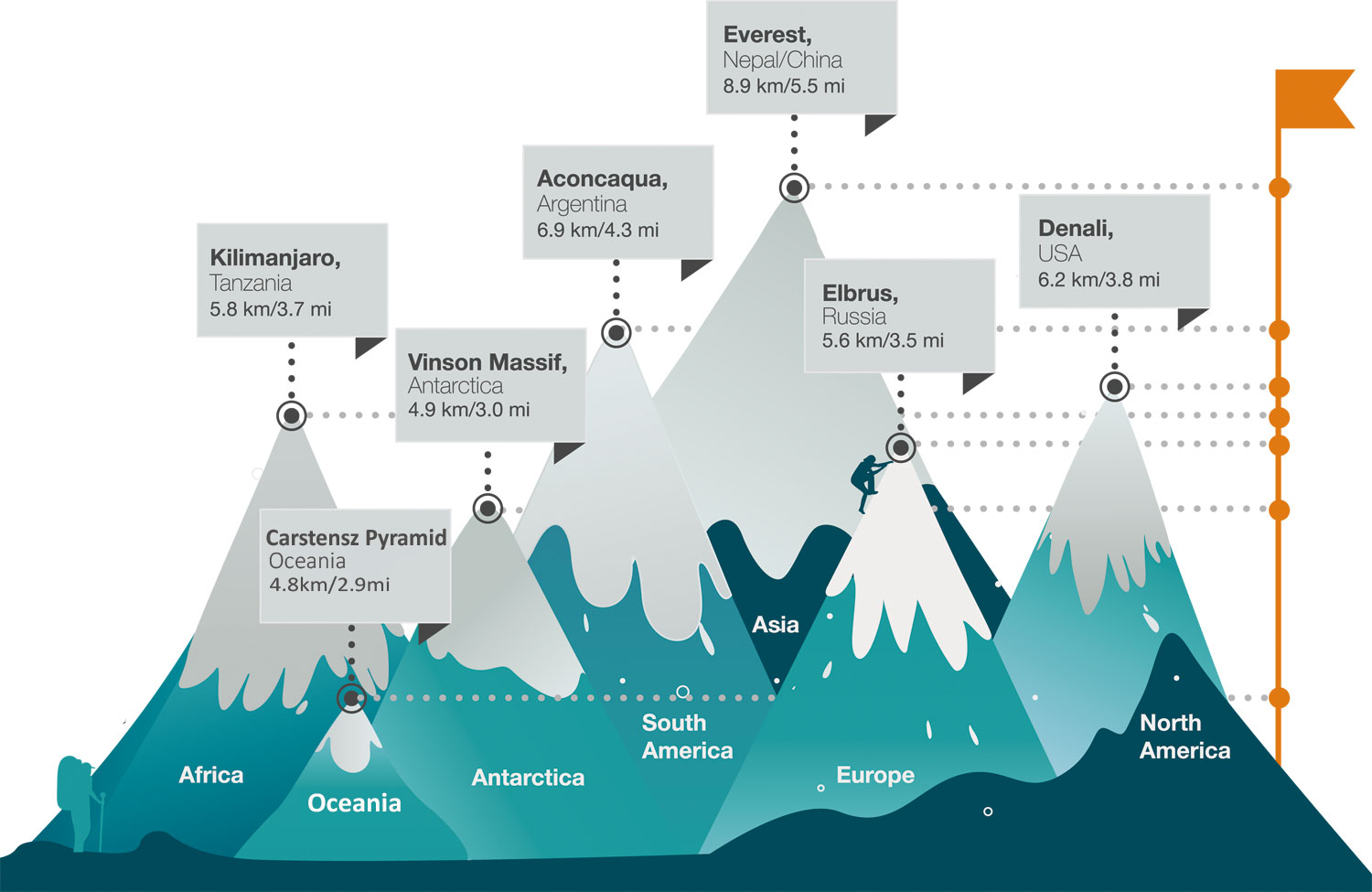

For professional climbers all over the world, there is but one primary goal everyone seemed to share — climb all the seven highest summits in the world. The seven summits are the highest mountains located in each of the seven continents.
The first to climb all summits was American climber Dick Bass. Starting with six summits in 1983, he was guided by David Breashears to climb the summit of Everest in 1985. As of 2016, over 400 people have successfully completed reaching the peak of all seven summits.
Mount Everest, Nepal
29,035’/8850m
Known in Nepali as Sagarmāthā and in Tibetan as Chomolungma, Mount Everest is the earth’s highest mountain above sea level. Located in the Mahalangur Himal sub-range of the Himalayas, the international border between China and Nepal across its summit point.
Mount Everest attracts many climbers, some of them highly experienced mountaineers. Mt Everest was first summited by Sherpa Tenzing Norgay and Edmund Hillary with a British expedition in 1953. Everest presents dangers such as altitude sickness, weather, and wind, as well as significant hazards from avalanches and the Khumbu Icefall.
Aconcagua, Argentina
22,902’/6960m
The highest mountain outside Asia, at 6,960.8 metres (22,837 ft), Aconcagua, which translates as “Stone Sentinel,” highest mountain in the Americas and is located in the Andes mountain range, in the Mendoza Province.
This spectacular mountain is surrounded by numerous peaks over 20,000 ft. The surrounding lowlands (up to 13,000 ft.) consist of beautiful desert landscapes with a large diversity of flora and fauna. Though an ascent of Aconcagua by any of these routes requires minimal technical skills, it does require excellent physical condition and good backpacking and camping skills.
Denali, Alaska
20,320’/6194m
Denali is the third most prominent and third most isolated peak on Earth, after Mount Everest and Aconcagua. Located in the Alaska Range in the interior of the U.S. state of Alaska, Denali is the centerpiece of Denali National Park and Preserve.
The Koyukon people who inhabit the area around the mountain have referred to the peak as “Denali” for centuries. It is classified as an extremely challenging expedition due to the severe weather and difficulty in acclimating. Because of its far northern latitude of 63 degrees, Denali has lower barometric pressure than the world’s other high mountains.
Kilimanjaro, Africa
19,341’/5895m
Mount Kilimanjaro with its three volcanic cones, “Kibo”, “Mawenzi”, and “Shira”, is a dormant volcano in Tanzania. It is the highest mountain in Africa, about 4,900 metres (16,100 ft) from its base to 5,895 metres (19,341 ft) above sea level.
There’s plenty of wildlife on the mountain, though your chances of seeing much are slim. This is largely because the animals prefer to avoid those parts of the mountain where more than 40,000 people tread every year.
Kilimanjaro’s main claim to fame is that it is the highest Mountain in Africa. It is also said to be the tallest free-standing mountain in the world as it’s not part of a mountain range but stands all by itself in the heart of the East African plains.
Elbrus, Russia
18,513’/5642m
The highest mountain in Europe, and the tenth most prominent peak in the world.[6] A dormant volcano, Elbrus is in the Caucasus Mountains in Southern Russia, near the border with Georgia.
Elbrus has two summits, both of which are dormant volcanic domes.
Snowfields of blinding white ascend gradually, allowing climbers to see far and wide. The snow can be deep and soft or, in peak season, firm and crunchy underfoot. In one section, climbers must use fixed ropes. Here, the gradient is steeper with a vertiginous drop to the basin below.
The ancients knew the mountain as Strobilus, Latin for “pine cone”, a direct loan from the ancient Greek strobilos, meaning ‘a twisted object’ – a long-established botanical term that describes the shape of the volcano’s summit. In Greek mythology, the Titan Prometheus was chained to the mountain by Zeus as a punishment for stealing fire from the gods and giving it to mankind.
Vinson, Antarctica
16,067’/4897m
A large mountain massif in Antarctica that is 21 km (13 mi) long and 13 km (8.1 mi) wide and lies within the Sentinel Range of the Ellsworth Mountains. It overlooks the Ronne Ice Shelf near the base of the Antarctic Peninsula. Vinson Massif was discovered in January 1958 by U.S. Navy aircraft, Adventure Consultants pioneered guided ascents of Vinson Massif in 1990 and has been operating successful trips to the mountain ever since.
Climbed for the first time in 1966, Vinson still sees very few visitors and remains a pristine and majestic peak.
Carstensz Pyramid, New Guinea
16,023’/4884m
Puncak Jaya is the highest mountain in Indonesia, on the island of New Guinea (which consists of the Indonesian West Papua region plus Papua New Guinea), on the continent of Australia (which consists of New Guinea, the country of Australia, Timor, other islands, and submerged continental shelf), and in Oceania, as well as the 5th highest mountain in political Southeast Asia.
Being equatorial, there is little variation in the mean temperature during the year (around 0.5°C) and the glaciers fluctuate on seasonal basis only slightly. It is located in what is variously called the Sudirman Range or the Dugunduguoo, in the western central highlands of Papua, just fifty miles from the island’s southern shore. Much of this range is characterised by easy terrace, surmounted by severe rock walls.
Oman Observer is now on the WhatsApp channel. Click here



